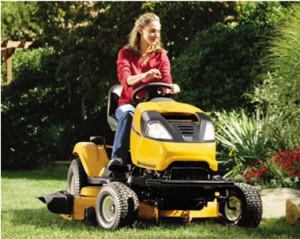Almost everyone who lives outside a city center knows how to mow a lawn, but that doesn’t mean they know how to do it well. By making a few changes to your mowing habits, you can get a healthier, better looking lawn.
Staying Safe
Check the lawn before you mow. A loose rock or hidden toy can turn into a dangerous projectile once it’s hit by your mower’s blades. Once you’re underway, shut off the engine before crossing areas that aren’t grass-covered. If the blade hits pavement, it can snap or make the mower buck violently.
Small engines are loud. While your first concern may be annoying your neighbors, it should be your ears. Always wear hearing protection when using your mower.
Run out of fuel? Take a break. If you give the mower a few minutes to cool down, it’s far less likely that a small spill from your fuel will turn into a fire. Once the tank is topped up, roll your mower a few feet away before starting. This keeps the engine heat from igniting any lingering fumes.
Mowing Height
This is one of the most common mistakes in lawn care: homeowners think that mowing lower means they’ll need to mow less often. While that’s technically true, it also damages the grass: damaged crowns are hard to repair, a lack of leaf area limits the amount of energy the grass can produce, and grass can be cut away entirely through scalping.
How short should you cut the grass? It depends on the varieties that are growing on your lawn. These are the recommended heights for common turf grasses:
- Bent: ¼ to 1 inch
- Hybrid Bermuda: ½ to 1 inch
- Common Bermuda: ¾ to 1 ½ inches
- Centipede and zoysia: 1 to 2 inches
- Ryegrass: 1 ½ to 2 inches
- Fine fescue and St. Augustine: 1 ½ to 2 ½ inches
- Kentucky bluegrass: 1 ¾ to 2 ½ inches
- Bahia, tall fescue, buffalo and blue grama: 2 to 3 inches
Keep the grass longer in stressful conditions, whether temperatures are high or sun-loving grass is trying to grow in the shade.
Only mow 1/3 of the total length of grass at one time to make it easier for the plants to recover. If you let the grass get too long, do one pass to shorten the grass, then wait a couple days before making a second pass to get it to the right height.
When you seed new grass, let it grow until it’s at least one inch higher than the recommended cutting height.
When to Mow
Avoid mowing when the ground is wet. This makes it harder for the blades to cut through the grass, and the weight of the mower can compact the soil, leading to root damage and drainage problems.
If your mower can mulch, this mode should be used most of the time. Switching to side discharge will get a better cut on wet grass, while bagging can be used to stop the spread of weeds.
If you’re using the side discharge, mow in a circle, aiming the clippings inward. This lets your mower chop up larger clippings into a smaller size that’s easier for the soil to digest.
Mowing Around Trees
A mower can do major damage to trees by slicing into exposed roots and damaging bark during impacts. If you want to protect your trees, add some landscaping around the trunk so you can keep your distance. This also helps the tree stay cool and retain water in the summer.
Use Quality Parts to Get a Quality Finish
Do you want to start mulching? Is your mower due for some new blades or some general maintenance? Everything you need for your Cub Cadet is available from www.cubparts.com. We’re a dealer for Cub Cadet and their manufacturing partners including Kawasaki, Kohler and Briggs & Stratton, which means we’re able to offer everything you may need for your mower. Our site lets you look at parts diagrams and descriptions for your model straight from the manufacturer so you can be sure you’re ordering exactly what you need. We ship to both the US. and Canada.

